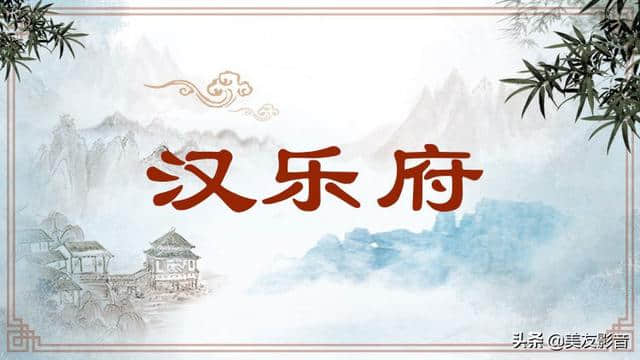汉乐府
Yuefu Poetry

- 图片来源:学习强国
指汉代的乐府诗。“乐府”本是秦以后由朝廷设立的用来训练乐工、采集民歌并配器作曲的专门官署,后转指由乐府机关所采集、配乐并由乐工演唱的民歌。乐府诗是继《诗经》之后古代民歌的一次创造,是与“诗经”“楚辞”并列的诗歌形态。至今保存的汉乐府民歌有五六十首,大都真实反映了当时社会生活的各个方面,表现出纯真质朴的思想感情,并由此形成反映普通民众声音与情感的文学创作传统。其中最有特色与成就的是描写女性生活的作品。汉代以后将可以入乐的诗歌及仿乐府古题而写的诗歌统称为乐府。
Yuefu (乐府) poems were written in the Han Dynasty. Originally, yuefu was a government office set up by the imperial court to train musicians, collect folk songs and ballads, compose music, and match musical instruments to it. It later came to refer to folk songs and ballads collected, matched with music, and played by court musicians. Poems of this style represented a new creation of ancient folk songs and ballads in the years after "The Book of Songs" was compiled, and equaled "The Book of Songs" and "Odes of Chu" in importance. About 50 to 60 yuefu poems have been handed down to this day. They truthfully depicted various aspects of society at the time and revealed genuine emotions, thus creating a literary tradition reflecting ordinary people's sentiments. In particular, yuefu poems were noted for their vivid depiction of women's life. All poems that could be chanted or were written with yuefu themes were collectively called yuefu poems in later times.

引例 Citations:
◎自孝武立乐府而采歌谣,于是有代、赵之讴,秦、楚之风。皆感于哀乐,缘事而发……(《汉书•艺文志》)
自从汉武帝设立乐府并采集歌谣,这之后就有了代、赵之地的吟唱及秦、楚等地的民歌。它们都是受内心悲喜情绪的影响或者受到某件事情的触发而产生的……
After Emperor Wu of the Han Dynasty set up an office to collect folk songs and ballads, folk songs from the Dai and Zhao regions, and ballads from the Qin and Chu regions could be heard. They were all created to express people's joy and sorrow or were inspired by certain events… (The History of the Han Dynasty)
◎乐府者,“声依永,律和声”也。(刘勰《文心雕龙•乐府》)
乐府诗,就是“随诗的吟唱而有抑扬疾徐的声音变化,再用音律调和声音”。
Yuefu poems vary in rhythm and tone and are accompanied by music when chanted. (Liu Xie: The Literary Mind and the Carving of Dragons)
(推荐:教育部 国家语委 供稿:北京外国语大学 外语教学与研究出版社)